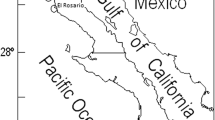Summary
The three plant exudatesgum traganth,gum arabic, andgum karaya and the two seaweed extracts carrageenan and alginate were degraded by five different Bacilli which were isolated from these gums:Bacillus coagulans,B. lentos,B. cereus,B. licheniformis, andB. firmus.
After 14 days all the gums have been degraded by these Bacilli to a different extent after addition of trace elements.
The fractions of degraded gums by TLC, GLC, and IR-spectroscopy have been examined with the following results:
-
1.
Except the already known monomers of the above mentioned gums no other monosaccharides could be found.
-
2.
The microbial degradation ofgum karaya and alginate resulted in products with a high molecularweight. Monomers could not be determined.
-
3.
Carrageenan has been degraded to oligosaccharides with molecular-weights of about 500, 3,6-anhydrogalactose has been partly identified.
-
4.
Gum arabic has been partly degraded to rhamnose and arabinose.
-
5.
Gum traganth has been partly degraded to arabinose and xylose and partly to polysaccharides with molecularweights under 3000.
Zusammenfassung
Es wurde der Abbau von Gummi traganth,Gummi arabicum,Gummi karaya,Carrageen und Alginat durch 5 verschiedene aus diesen Verdickungsmitteln isolierteBacillus-Arten untersucht:Bacillus coagulans,B. lentus,B. cereus,B. licheniformis undB. firmus. Sämtliche Verdickungsmittel wurden durch dieseBacillus-Arten nach 14 Tagen bei Zusatz Von Spurenelementen mehr oder weniger stark abgebaut.
Die DC-, GC- und IR-spektroskopischen Untersuchungen der Fraktionen der Abbauprodukte brachten folgende Ergebnisse:
-
1.
Außer den in den genannten Verdickungsmitteln bereits bekannten Monosacchariden wurden keine anderen Zucker nachgewiesen.
-
2.
Der mikrobielle Abbau vonGummi karaya und Alginat führte zu Verbindungen mit hohem Molekulargewicht. Monosaccharide konnten nicht erfaßt werden.
-
3.
Carrageen wurde zu Oligosacchariden mit einem bei ca. 500 liegendem Molekulargewicht abgebaut, z. T. konnte 3,6-Anhydrogalaktose identifiziert werden.
-
4.
Gummi arabicum wurde z. T. zu Rhamnose und Arabinose abgebaut.
-
5.
Gummi traganth wurde z. T. zu Arabinose und Xylose und z. T. zu Polysacchariden mit unter 3000 liegenden Molekulargewichten abgebaut.
Similar content being viewed by others
Literatur
Souw,P., Rehm,H.J.: Chem. Mikrobiol. Technol. Lebensur.2,188 (1973)
Souw,P., Rehm,H.J.: Chem. Mikrobiol. Technol. Lebensm. (im Druck) (1975)
Souw,P., Rehm,H.J.: Chem. Mikrobiol. Technol. Lebensm. (im Druck) (1975)
Schmolck,W., Mergenthaler,E.: Z. Lebensm. Unters.-Forsch.152, 87 (1973);152, 263 (1973)
Jones,J.K.N., Smith,F.: Plant Gums and Mucilages. Advan. Carbohyd. Chem.4, 243 (1949)
James,S.P., Smith,F.: J. Chem. Soc.1945, 749
Glicksman,M.: Gum technology in the food industry. New York, London: Academic Press 1969
Hirst, E. L.: Society of chemical industry, London. Monograph24, 3 (1966) (zit. nach Glicksman)
Aspinall, G. 0., Nasir Ud Din: J. Chem. Soc.1965, 2710
Genu Carrageenan, Dänemark: A/S Københavns Pektinfabrik 1971
Aspinall,G.O., Baillie,J.: J. Chem. Soc.1963,1702
Raymond,W.R., Nagel,C.W.Carbohyd. Res.30, 293 (1973)
Waksman,S.A., Carey,C.L., Allen,M.C.: J. Bacteriol.28, 213 (1934)
Hansen,J.E., Kåss,E.: Acta Path. Mikrobiol. Scand.23, 140 (1946)
Käss, E., Lid, I., Molland, J.: Avhandl. Norske Videnskap-Akad. Oslo. I. Mat.-Naturv. Klasse1945, Nr. 11, 1–22 (zit. nach Maass, H.: Alginsäure und Alginate. Heidelberg: Straßenbau, Chemie und Technik Verlag 1959)
Thjotta,T., Kiss,E.: Avhandl. Norske Videnskap-Akad. Oslo. Mat.-Naturv.5, 1–20 (1954)
Kooiman,P.: Biochim. Biophys. Acta13, 338 (1954)
Souw, P.: Kontamination und Abbau pflanzlicher Verdickungsmittel durch Mikroorganismen, S. 114. Diss. Univ. Münster 1974
Stahl,E.: Dünnschichtchromatographie. Berlin, Heidelberg, New York: Springer 1967
Mezzetti,T., Ghebregziabhier,M., Rufmi,S., Ciuffini,G., Lato,M.: J. Chromatog.74, 273 (1972)
Stanley,N.F.: US Patent Nr. 3094517 (1963)
Sloneker,J.H.: In: Methods in carbohydrate chemistry, Vol. VI, p. 20. New York, London: Academic Press 1972
Sweeley,C.C., Bentley,R., Makita,M., Wells,W.W.: J. Am. Chemists Soc.85, 2497 (1963)
Clingman,A.L., Nunn,J.R., Stophen,A.M.: J. Chem. Soc. 1957, 197
Goepfert,J.M., Spira,W.M., Kim,H.U.: J. Milk Food Technol.35,213 (1972)
Author information
Authors and Affiliations
Additional information
Diese Untersuchung wurde vom Bundesministerium für Jugend, Familie und Gesundheit unterstützt.
Rights and permissions
About this article
Cite this article
Souw, P., Jürgen, H. Mikroorganismen in Verdickungsmitteln IV. Mikrobieller Abbau von drei Pflanzenexudaten und zwei Meeresalgenextrakten. Z Lebensm Unters Forch 159, 297–304 (1975). https://doi.org/10.1007/BF01139584
Received:
Issue Date:
DOI: https://doi.org/10.1007/BF01139584




